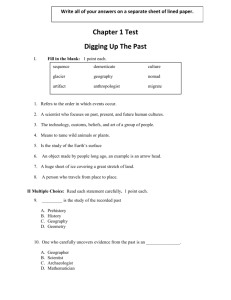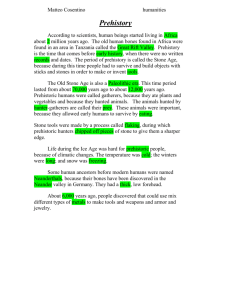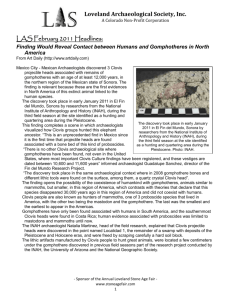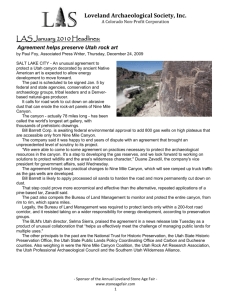March 2012 Monthly Newsletter - Loveland Archaeological Society
advertisement
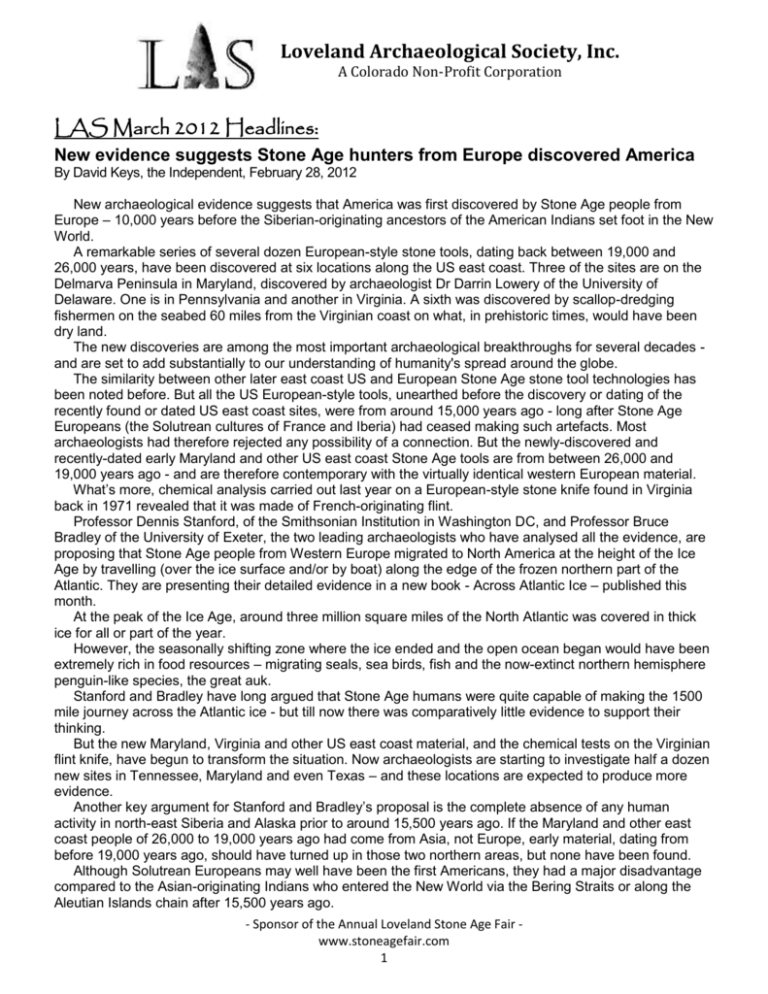
Loveland Archaeological Society, Inc. A Colorado Non-Profit Corporation LAS March 2012 Headlines: New evidence suggests Stone Age hunters from Europe discovered America By David Keys, the Independent, February 28, 2012 New archaeological evidence suggests that America was first discovered by Stone Age people from Europe – 10,000 years before the Siberian-originating ancestors of the American Indians set foot in the New World. A remarkable series of several dozen European-style stone tools, dating back between 19,000 and 26,000 years, have been discovered at six locations along the US east coast. Three of the sites are on the Delmarva Peninsula in Maryland, discovered by archaeologist Dr Darrin Lowery of the University of Delaware. One is in Pennsylvania and another in Virginia. A sixth was discovered by scallop-dredging fishermen on the seabed 60 miles from the Virginian coast on what, in prehistoric times, would have been dry land. The new discoveries are among the most important archaeological breakthroughs for several decades and are set to add substantially to our understanding of humanity's spread around the globe. The similarity between other later east coast US and European Stone Age stone tool technologies has been noted before. But all the US European-style tools, unearthed before the discovery or dating of the recently found or dated US east coast sites, were from around 15,000 years ago - long after Stone Age Europeans (the Solutrean cultures of France and Iberia) had ceased making such artefacts. Most archaeologists had therefore rejected any possibility of a connection. But the newly-discovered and recently-dated early Maryland and other US east coast Stone Age tools are from between 26,000 and 19,000 years ago - and are therefore contemporary with the virtually identical western European material. What’s more, chemical analysis carried out last year on a European-style stone knife found in Virginia back in 1971 revealed that it was made of French-originating flint. Professor Dennis Stanford, of the Smithsonian Institution in Washington DC, and Professor Bruce Bradley of the University of Exeter, the two leading archaeologists who have analysed all the evidence, are proposing that Stone Age people from Western Europe migrated to North America at the height of the Ice Age by travelling (over the ice surface and/or by boat) along the edge of the frozen northern part of the Atlantic. They are presenting their detailed evidence in a new book - Across Atlantic Ice – published this month. At the peak of the Ice Age, around three million square miles of the North Atlantic was covered in thick ice for all or part of the year. However, the seasonally shifting zone where the ice ended and the open ocean began would have been extremely rich in food resources – migrating seals, sea birds, fish and the now-extinct northern hemisphere penguin-like species, the great auk. Stanford and Bradley have long argued that Stone Age humans were quite capable of making the 1500 mile journey across the Atlantic ice - but till now there was comparatively little evidence to support their thinking. But the new Maryland, Virginia and other US east coast material, and the chemical tests on the Virginian flint knife, have begun to transform the situation. Now archaeologists are starting to investigate half a dozen new sites in Tennessee, Maryland and even Texas – and these locations are expected to produce more evidence. Another key argument for Stanford and Bradley’s proposal is the complete absence of any human activity in north-east Siberia and Alaska prior to around 15,500 years ago. If the Maryland and other east coast people of 26,000 to 19,000 years ago had come from Asia, not Europe, early material, dating from before 19,000 years ago, should have turned up in those two northern areas, but none have been found. Although Solutrean Europeans may well have been the first Americans, they had a major disadvantage compared to the Asian-originating Indians who entered the New World via the Bering Straits or along the Aleutian Islands chain after 15,500 years ago. - Sponsor of the Annual Loveland Stone Age Fair www.stoneagefair.com 1 Loveland Archaeological Society, Inc. A Colorado Non-Profit Corporation Whereas the Solutreans had only had a 4500 year long ‘Ice Age’ window to carry out their migratory activity, the Asian-originating Indians had some 15,000 years to do it. What’s more, the latter two-thirds of that 15 millennia long period was climatologically much more favourable and substantially larger numbers of Asians were therefore able to migrate. As a result of these factors the Solutrean (European originating) Native Americans were either partly absorbed by the newcomers or were substantially obliterated by them either physically or through competition for resources. Some genetic markers for Stone Age western Europeans simply don’t exist in north- east Asia – but they do in tiny quantities among some north American Indian groups. Scientific tests on ancient DNA extracted from 8000 year old skeletons from Florida have revealed a high level of a key probable Europeanoriginating genetic marker. There are also a tiny number of isolated Native American groups whose languages appear not to be related in any way to Asian-originating American Indian peoples. But the greatest amount of evidence is likely to come from under the ocean – for most of the areas where the Solutreans would have stepped off the Ice onto dry land are now up to 100 miles out to sea. The one underwater site that has been identified – thanks to the scallop dredgers – is set to be examined in greater detail this summer – either by extreme-depth divers or by remotely operated mini submarines equipped with cameras and grab arms. Recommended Periodicals Prehistoric American Magazine Prehistoric American magazine is published by the Genuine Indian Relic Society (GIRS). The magazine is published quarterly, so you’ll receive four copies each year. Annual membership is $30. For membership inquiry, subscriptions or information use this address: G.I.R.S., Inc. P. O. Box 694, 302 E. Walnut St. Robinson, IL 62454-0694 Their website can be accessed at www.prehistoricamerican.net. Many of our members may remember Gene and Jeanne Hynek from Wisconsin who are regular exhibitors at the annual Loveland Stone Age Fair. Gene is the Editor in Chief for Prehistoric American. It’s a fantastic publication you’ll eagerly look for in your mail box! - Sponsor of the Annual Loveland Stone Age Fair www.stoneagefair.com 2 Loveland Archaeological Society, Inc. A Colorado Non-Profit Corporation LAS Find of the Month, March 2012: Members can bring an artifact to be entered into the competition at the monthly meeting, which will be judged based on the following rules: 1. 2. 3. 4. Must be a member of LAS in good standing. The artifact must be a personal find. It must have been found within the specified time frame, i.e., within the month prior to the meeting. The artifact doesn’t have to be a Colorado find—all that matters is that it was found in the last month. The Find of the Month for March 2012 was made by Steve Campbell. Type: Frederick Material: Patinated Agate Location: Larimer County, Colorado LAS News and Upcoming Events: March 23-25, 2012 51st Annual Fort Collins Rockhounds Gem and Mineral Show at the Thomas M. McKee 4-H, Youth & Community Building, Larimer County Fairgrounds. This year’s Gem and Mineral Show features “Fossils & Quartz.” Admission for adults is $4 daily or $7 for a 3-day pass. For students (12-18 years) with ID admission is $1 daily. Children under 12 are free with an adult. Parking is free. Hours: March 23rd 4 – 8 pm, March 24th 9 am – 6 pm, March 25th 10 am – 5 pm. For more information see the website at www.fortcollinsrockhounds.org. April 3, 2012 April meeting. Guest Speaker: Mr. Stephen Schell. Mr. Schell will give a presentation on rock art of southern Utah with a special emphasis on Horseshoe Canyon outside Moab, Utah. April 7, 2012 2012 Spring Into Archaeology Fair, Poudre Valley REA Building. If you plan to exhibit please call Andy Coca at (303) 286-7711 for table space. A flyer with directions to the REA Building is attached. See you there! May 1, 2012 May meeting. Guest Speaker: Mark Boswell. LAS member Mark Boswell will give a presentation on Navajo textiles. He will talk about the history of Navajo textiles and then provide a show and tell on how you can determine if a textile has been made by the Navajo, the approximate age and the use. Members are encouraged to bring in your own textiles for evaluation. - Sponsor of the Annual Loveland Stone Age Fair www.stoneagefair.com 3 Loveland Archaeological Society, Inc. A Colorado Non-Profit Corporation - Sponsor of the Annual Loveland Stone Age Fair www.stoneagefair.com 4


